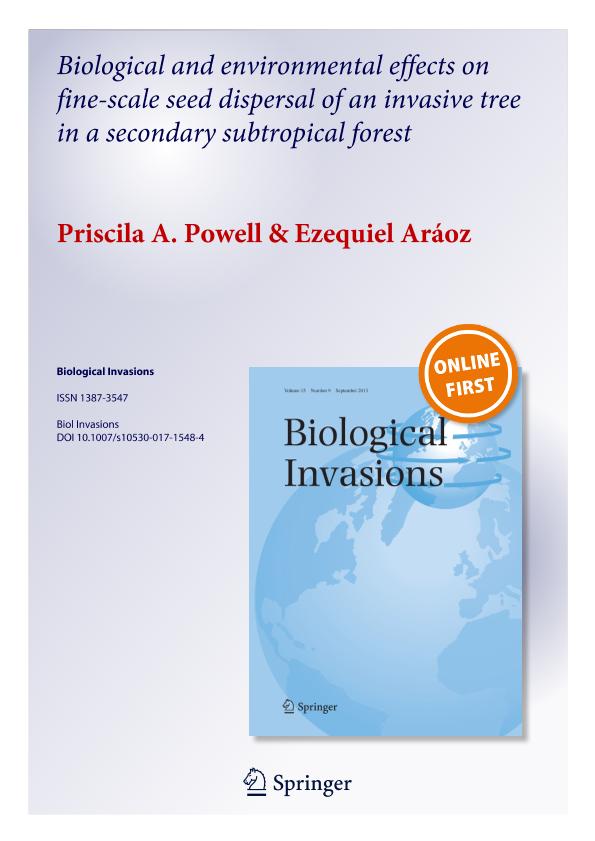Mostrar el registro sencillo del ítem
dc.contributor.author
Powell, Priscila Ana

dc.contributor.author
Aráoz, Ezequiel

dc.date.available
2018-09-07T19:26:00Z
dc.date.issued
2018-02
dc.identifier.citation
Powell, Priscila Ana; Aráoz, Ezequiel; Biological and environmental effects on fine-scale seed dispersal of an invasive tree in a secondary subtropical forest; Springer; Biological Invasions; 20; 2; 2-2018; 461-473
dc.identifier.issn
1387-3547
dc.identifier.uri
http://hdl.handle.net/11336/58810
dc.description.abstract
Dispersal abilities of invading species emerge from the interaction between the species and some features of the target community. Ligustrum lucidum is a tree species invading different ecosystems. Major spatial patterns of Ligustrum invasions and their ecological consequences have been analyzed, but no study addressed the dispersal process at a fine scale, assessing the effects of different biological and environmental factors. Ligustrum lucidum is an ornithochoric species. The structure of the environment determines bird movements and thus affects seed dispersal. We used inverse modeling to analyze bird-mediated dispersal of L. lucidum seeds in a secondary Yungas forest and surrounding crop-fields. We assessed the effects of egestion mode (regurgitation and defecation) and tree density (as an environment character) on seed dispersal. Seed dispersal presented different spatial patterns depending on the egestion mode. Tree density was positively associated with the number of regurgitated dispersed seeds and negatively associated with the number of defecated dispersed seeds. In both cases, dispersal distance increased in open areas, but absence of perches inhibited seed arrival. Thus, spread of L. lucidum is facilitated in open areas with some trees; inside the native forest, short distance dispersal facilitates the gradual invasion by this exotic species. Our results suggest that processes like crop abandonment and forest succession, which are active in subtropical montane systems, may facilitate L. lucidum invasion. Our seed dispersal models should be combined with actual distribution maps of L. lucidum to identify areas vulnerable to new invasions.
dc.format
application/pdf
dc.language.iso
eng
dc.publisher
Springer

dc.rights
info:eu-repo/semantics/openAccess
dc.rights.uri
https://creativecommons.org/licenses/by-nc-sa/2.5/ar/
dc.subject
Bird-Mediated Dispersal
dc.subject
Dispersal Kernel
dc.subject
Ligustrum Lucidum
dc.subject
Yungas
dc.subject.classification
Otras Ciencias Biológicas

dc.subject.classification
Ciencias Biológicas

dc.subject.classification
CIENCIAS NATURALES Y EXACTAS

dc.title
Biological and environmental effects on fine-scale seed dispersal of an invasive tree in a secondary subtropical forest
dc.type
info:eu-repo/semantics/article
dc.type
info:ar-repo/semantics/artículo
dc.type
info:eu-repo/semantics/publishedVersion
dc.date.updated
2018-09-04T16:36:57Z
dc.journal.volume
20
dc.journal.number
2
dc.journal.pagination
461-473
dc.journal.pais
Alemania

dc.journal.ciudad
Heidelberg
dc.description.fil
Fil: Powell, Priscila Ana. Universidad Nacional de Tucumán. Instituto de Ecología Regional. Consejo Nacional de Investigaciones Científicas y Técnicas. Centro Científico Tecnológico Conicet - Tucumán. Instituto de Ecología Regional; Argentina. Universidad Nacional de Tucumán. Facultad de Ciencias Naturales e Instituto Miguel Lillo. Cátedra de Ecología General; Argentina
dc.description.fil
Fil: Aráoz, Ezequiel. Universidad Nacional de Tucumán. Instituto de Ecología Regional. Consejo Nacional de Investigaciones Científicas y Técnicas. Centro Científico Tecnológico Conicet - Tucumán. Instituto de Ecología Regional; Argentina. Universidad Nacional de Tucumán. Facultad de Ciencias Naturales e Instituto Miguel Lillo; Argentina
dc.journal.title
Biological Invasions

dc.relation.alternativeid
info:eu-repo/semantics/altIdentifier/doi/https://dx.doi.org/10.1007/s10530-017-1548-4
dc.relation.alternativeid
info:eu-repo/semantics/altIdentifier/url/https://link.springer.com/article/10.1007%2Fs10530-017-1548-4
Archivos asociados
